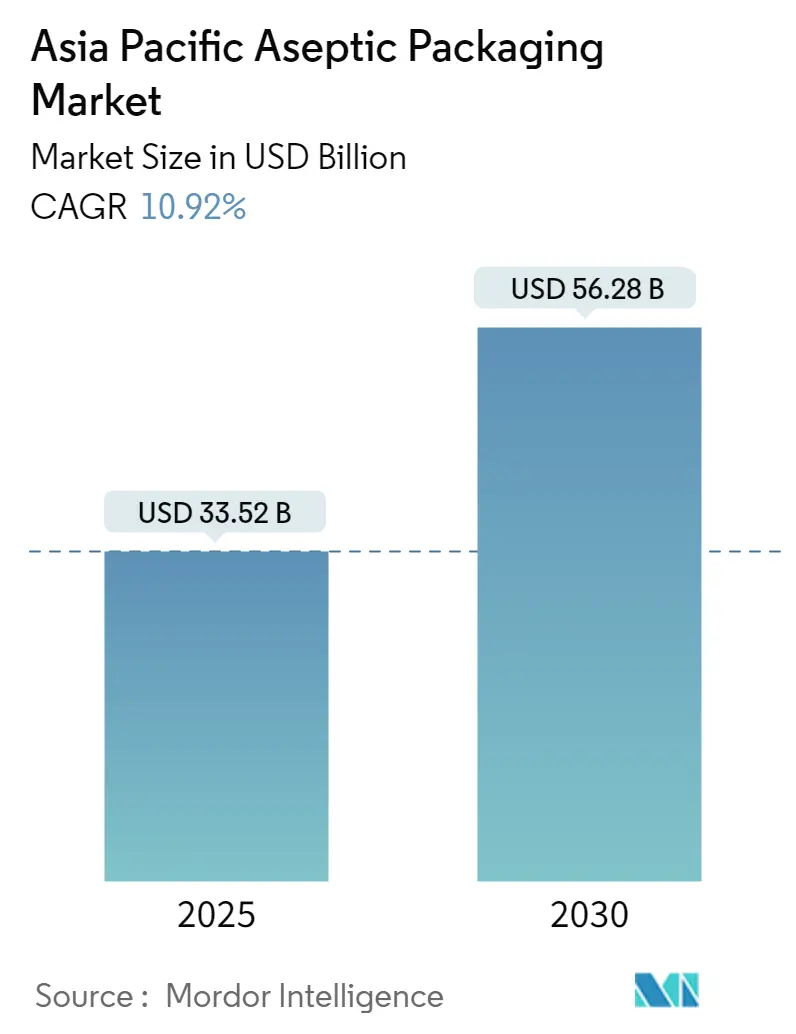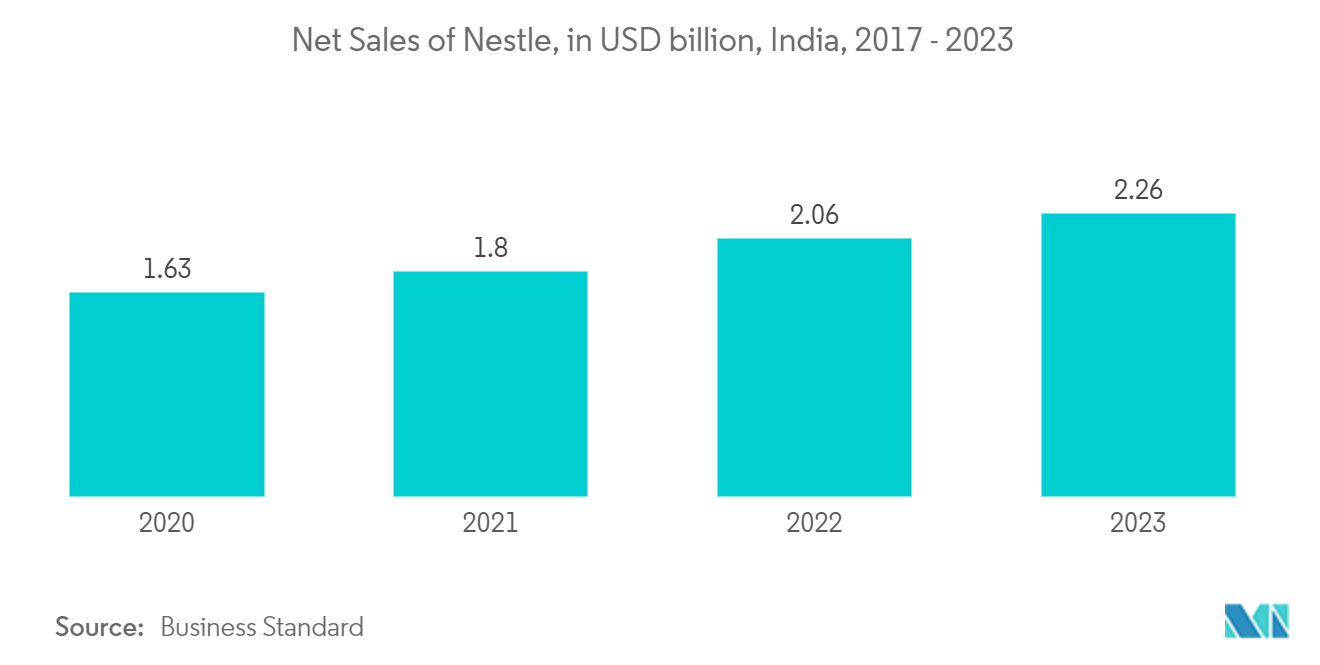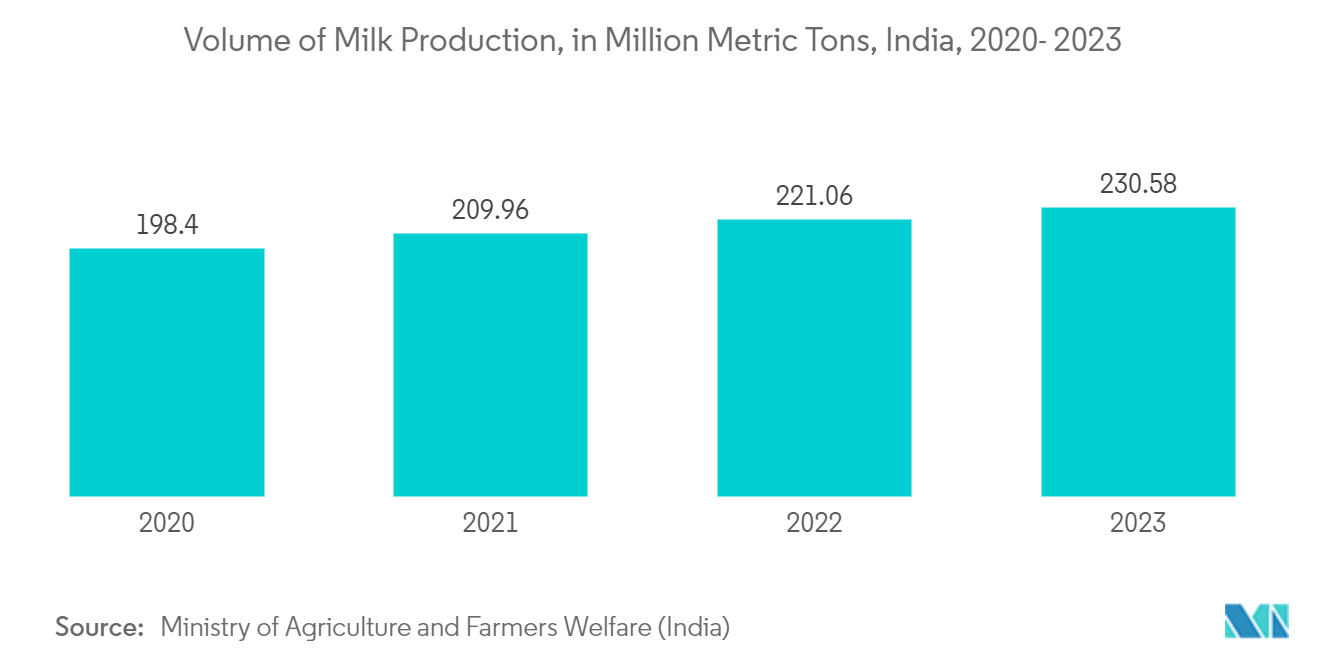
Asia Pacific Aseptic Packaging Market Analysis by Mordor Intelligence
The Asia Pacific Aseptic Packaging Market size is worth USD 33.52 Billion in 2025, growing at an 10.92% CAGR and is forecast to hit USD 56.28 Billion by 2030.
- The Asia-Pacific aseptic packaging market is primarily driven by countries such as India, China, and Japan. Increased disposable income and growth in the food and beverage industry have prompted several countries in the region to adopt aseptic packaging solutions. This trend will create opportunities for the aseptic packaging market in the coming years.
- Evolving consumer eating habits in the region have led to an increased preference for ready-to-eat meals and a higher demand for convenient, high-quality food products, fostering market growth. This shift is particularly evident in urban areas where time constraints and busy lifestyles are driving the need for quick and easy meal solutions. Players in the aseptic packaging market have responded by developing innovative packaging solutions that ensure food safety and extend shelf life, catering to these changing consumer needs.
- Aseptic technology significantly reduces packaging costs using more economical materials than traditional methods. This innovative approach also minimizes the need for preservatives, offering substantial consumer health and environmental sustainability benefits. Furthermore, aseptic technology enables the precision production of smaller beverage quantities, which helps decrease waste throughout the supply chain. This flexibility in production volume lowers overall manufacturing costs, as companies can better match production to demand. The technology's efficiency extends to energy consumption and storage requirements, enhancing its cost-effectiveness and environmental advantages in the beverage industry.
- Market players also invest in research and development to stay competitive in evolving industries. New product launches align with market trends and support demand. The pharmaceutical industry's increasing need for aseptic packaging contributes to market growth. Governments across various countries are raising healthcare sector spending, further boosting the aseptic packaging market. Thus, the growing demand for aseptic packaging from the pharmaceutical and food and beverage industries is expected to drive the market’s growth.
- For instance, SIG inaugurated its second production facility in Palghar, India, in April 2023. This plant manufactures SIG's bag-in-box and spouted pouch packaging, previously marketed under the Scholle IPN and Bossar brands. Located 90 km north of Mumbai, the new facility complements SIG's existing plant in Palghar, which produces components and finished packaging. The first plant has blown film extruders, injection molding cells, bag-in-box manufacturing machines, and a mold-making facility for packaging fitments and closures that are used in bag-in-box and spouted pouch products.
- Sustainable packaging and extended shelf life are crucial factors for consumers in the food and beverage industry. Consequently, many food and beverage vendors in the region opt for aseptic packaging, driven by cost efficiency and environmental considerations, particularly regarding transportation and storage in local conditions. The region's high demand for aseptic packaging is attributed to its use of recyclable cardboard and environmentally friendly materials. This packaging type is prevalent among consumers who prefer smaller quantities and make frequent purchases.
- The market is experiencing significant cost pressures due to rising polymer prices, which have increased the overall production expenses. Raw material costs have risen substantially since the onset of the pandemic. The Russia-Ukraine War further exacerbated this price escalation. Concurrently, the demand for plastics and plastic products continues to grow annually. The supply has not kept pace with this increasing demand, contributing to the upward trend in polymer prices.
Asia Pacific Aseptic Packaging Market Trends and Insights
The Beverages Segment is Expected to Hold a Significant Share
- Rapid urbanization in Asia-Pacific countries fuels the rising demand for beverages and natural products, including juices and flavored milk. The growing purchasing power of consumers in the region is a crucial factor contributing to the demand for aseptic cartons. The rising trend of healthier lifestyles and heightened awareness of hygiene, particularly in the aftermath of the pandemic, has significantly boosted the market for aseptic cartons across Asia-Pacific.
- Packaging plays a vital role in adding value and differentiating non-alcoholic beverages. As consumer interest in these products grows, the demand for effective packaging solutions is expected to increase. Packaging for non-alcoholic beverages must protect liquids from contamination and leakage during handling and storage. Aseptic packaging shields the contents from external elements for products such as juices and energy drinks. This packaging typically combines thermoplastics, paperboard, and aluminum foil to ensure product integrity.
- Aseptic technology significantly reduces packaging costs using more economical materials than traditional methods. This cost-effectiveness stems from the ability to use lighter, thinner packaging materials that still maintain product integrity. The technology also minimizes the need for preservatives, benefiting consumer health and the environment by reducing beverage chemical additives. Aseptic processing allows extended shelf life without refrigeration, which can lead to energy savings in storage and transportation.
- Additionally, this technology enables the production of smaller beverage quantities, which helps decrease waste by allowing for more precise production runs. This flexibility in production volume lowers overall production costs by reducing overproduction and inventory-holding expenses. Combining these factors makes aseptic technology an attractive option for beverage manufacturers looking to optimize their production processes and reduce operational costs.
- The demand for beverage packaging is expected to increase during the forecast period. Aseptic packaging, available in various sizes, is widely used for storing and distributing beverages, making it suitable for shipping and storage. The demand for aseptic packaging in this region will likely grow as consumers increasingly prefer safe and fresh products.
- Convenience has emerged as a significant trend in ready-to-drink beverages and health and well-being categories. Consumers prefer ready-to-drink cocktails due to the time-consuming nature of preparing beverages from scratch. The rise of ready-to-drink options has been a notable development across all beverage categories in recent years. Consumers are attracted to these drinks for their unique flavors and convenience outside the home.
- Nestle India Ltd announced the launch of a range of ready-to-drink variants of its renowned coffee brand, Nescafe. The company commenced the sale of ready-to-drink coffee for INR 30 per pack of 180 ml at retail outlets and through its e-commerce channel. This product uses aseptic packaging, which helps the company increase sales. Sales increased to USD 2.26 billion in 2023 from USD 1.21 billion in 2017. The rise in the demand for ready-to-drink products will also boost the aseptic packaging market in the region.
- Nestle India Ltd's introduction of ready-to-drink coffee variants represented a significant move in the beverages segment. Aseptic packaging plays a crucial role in preserving the quality and extending the shelf life of such products without the need for refrigeration. This packaging technology ensures that the coffee remains fresh and safe for consumption, even when stored at room temperature for extended periods.

India is Expected to Record High Growth During the Forecast Period
- India has made significant contributions to the dairy industry. Due to strict regulations on single-use plastics, market players have substantial opportunities to develop biodegradable and reusable aseptic packages. Sustainable packaging options include reusable materials such as polyethylene made from bioethanol, polylactic acid, micro-fibrillated cellulose, and other biodegradable materials.
- Population growth, rising incomes, and lifestyle changes drive the aseptic packaging industry. Increasing growth prospects in end-user segments are fueling the demand for aseptic packaging. However, the market's expansion is constrained by the increased use of alternative packaging options, particularly pouch packaging. India is expected to hold a significant share of the Asia-Pacific aseptic packaging market, propelled by the rapidly growing demand for packaged food products and increasing disposable incomes.
- India is the world's largest milk consumer, boasting a diverse and expansive dairy industry. Milk production in the country has shown significant growth over the past decade, with Uttar Pradesh and Rajasthan emerging as substantial contributors. This increase in milk production led to a corresponding rise in the demand for aseptic packaging, essential for maintaining the sterility and quality of milk and milk-based products.
- The Ministry of Agriculture and Farmers Welfare (India) reported that milk production reached an impressive 226 million metric tons in fiscal year 2023, a notable increase from the previous year's 221.6 million tons. However, the growth rate in milk production experienced a slight deceleration, decreasing from approximately 5.8% in the fiscal year 2023 to 3.83% in the following year.
- Despite this minor slowdown in growth rate, the overall upward trend in milk production continues to impact the market substantially. As milk production volumes increase, so does the need for reliable, sterile packaging solutions. This growing demand drives innovation and expansion in the market as manufacturers strive to meet the evolving needs of India's thriving dairy industry.
- Indian consumers are increasingly prioritizing health and wellness in their beverage choices, from morning juices to energy drinks, with consumers willing to spend more on refreshments that align with wellness goals. Consequently, there is a growing demand for cost-effective packaging solutions in the beverages segment. The milk and dairy beverage industries are particularly driving increased adoption of aseptic cartons, which offer advantages such as easy product stacking and extended shelf life.

Competitive Landscape
The Asia-Pacific aseptic packaging market is highly competitive due to multiple vendors operating in it. The market is semi-consolidated, with the players adopting various strategies, such as product innovations, mergers, and acquisitions, primarily to expand their reach and stay competitive. Some of the major players in the market include Tetra Pak International SA, Asepto (UFlex Ltd), and SIG Combibloc Group.
Asia Pacific Aseptic Packaging Industry Leaders
Tetra Pak International SA
Asepto( UFlex Ltd. )
SIG Combibloc Group
Mondi PLC
Ecolean Packaging
- *Disclaimer: Major Players sorted in no particular order
.webp)
Recent Industry Developments
- July 2024: Responding to increasing demand for closed dairy dispensing systems in the foodservice industry, Liquibox, a division of SEE (Sealed Air), introduced the Liquibox Universal Self-Sealing Cap. This innovation in closed milk bag-in-box and bag-in-tray systems marked a significant improvement in milk dispensing technology. It reduces food waste, enhances hygiene, extends product freshness, and improves cost efficiency compared to traditional pour-out packaging solutions like bottles and cartons.
- May 2024: Shandong NewJF Technology Packaging Co. Ltd (NEWJF), a prominent Chinese aseptic packaging company, acquired a 28.22% stake in Greatview Aseptic Packaging. This acquisition strengthened NEWJF's position in the liquid product packaging market.
Asia Pacific Aseptic Packaging Market Report Scope
Aseptic packaging is a technique for preserving liquid and other particulate foods. Sterilizing food packaging materials and contact surfaces is crucial in the aseptic packaging system. The food is sterilized outside the primary container, placed in a previously sterilized container, and sealed in an aseptic environment.
The Asia-Pacific aseptic packaging market is segmented by product (cartons, bags and pouches, cans, and bottles), application (beverages [ready-to-drink beverages and dairy-based beverages], food [processed food, fruit and vegetable, and dairy-based], pharmaceutical, and medical and other applications), and country (China, India, Southeast Asia, Japan, and Rest of Asia-Pacific). The market sizes and forecasts are provided in value terms (USD) for all the above segments.
| Cartons |
| Bags and Pouches |
| Cans |
| Bottles |
| Beverage | Ready-to-drink Beverages |
| Dairy-based Beverages | |
| Food | Processed Foods |
| Fruits and Vegetables | |
| Dairy Products | |
| Pharmaceutical & Medical | |
| Other Applications |
| China |
| India |
| Japan |
| South East Asia |
| By Product | Cartons | |
| Bags and Pouches | ||
| Cans | ||
| Bottles | ||
| By Applications | Beverage | Ready-to-drink Beverages |
| Dairy-based Beverages | ||
| Food | Processed Foods | |
| Fruits and Vegetables | ||
| Dairy Products | ||
| Pharmaceutical & Medical | ||
| Other Applications | ||
| By Country | China | |
| India | ||
| Japan | ||
| South East Asia | ||
Key Questions Answered in the Report
How big is the Asia Pacific Aseptic Packaging Market?
The Asia Pacific Aseptic Packaging Market size is worth USD 33.52 billion in 2025, growing at an 10.92% CAGR and is forecast to hit USD 56.28 billion by 2030.
What is the current Asia Pacific Aseptic Packaging Market size?
In 2025, the Asia Pacific Aseptic Packaging Market size is expected to reach USD 33.52 billion.
Who are the key players in Asia Pacific Aseptic Packaging Market?
Tetra Pak International SA, Asepto( UFlex Ltd. ), SIG Combibloc Group, Mondi PLC and Ecolean Packaging are the major companies operating in the Asia Pacific Aseptic Packaging Market.
What years does this Asia Pacific Aseptic Packaging Market cover, and what was the market size in 2024?
In 2024, the Asia Pacific Aseptic Packaging Market size was estimated at USD 29.86 billion. The report covers the Asia Pacific Aseptic Packaging Market historical market size for years: 2019, 2020, 2021, 2022, 2023 and 2024. The report also forecasts the Asia Pacific Aseptic Packaging Market size for years: 2025, 2026, 2027, 2028, 2029 and 2030.
Page last updated on:
Asia Pacific Aseptic Packaging Market Report
Statistics for the 2025 Asia Pacific Aseptic Packaging market share, size and revenue growth rate, created by Mordor Intelligence™ Industry Reports. Asia Pacific Aseptic Packaging analysis includes a market forecast outlook for 2025 to 2030 and historical overview. Get a sample of this industry analysis as a free report PDF download.
.webp)


